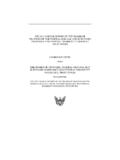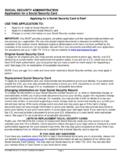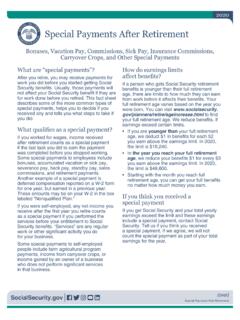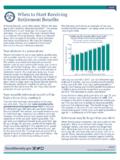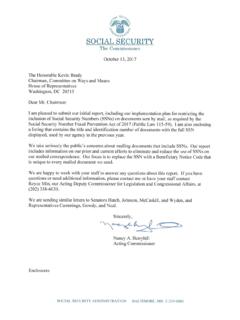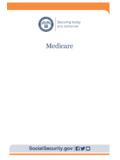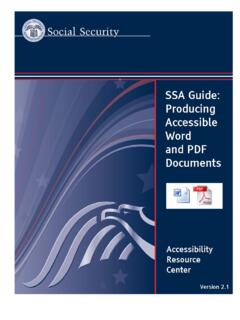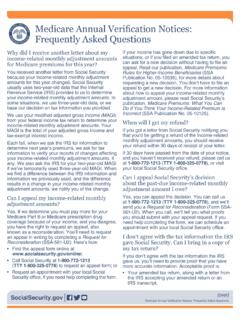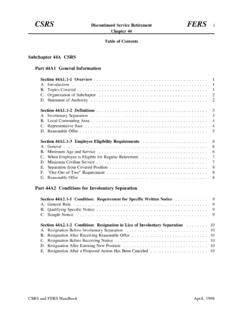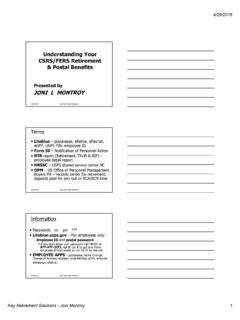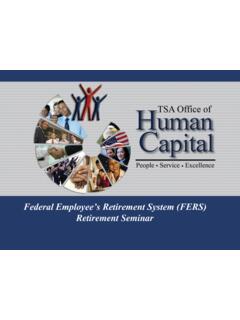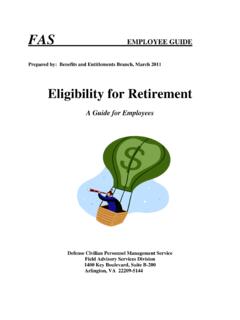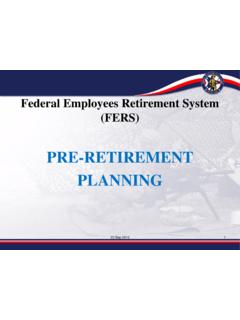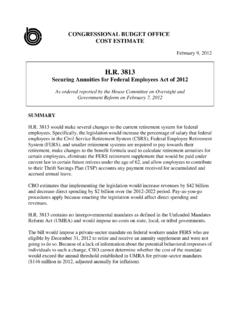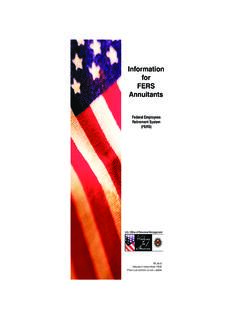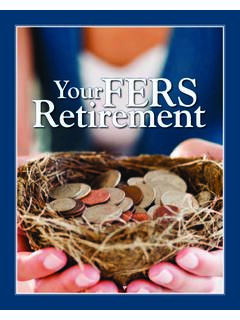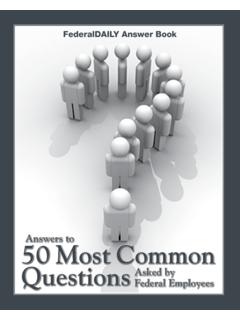Transcription of Federal Employees’ Retirement System Act of 1986
1 Federal Employees Retirement System Act of 1986 by Wilmer L. Kerns* In June, President Reagan signed the Federal Employees Re- tirement System Act of 1986 (Public Law 99-335), which estab- lishes the Federal Employees Retirement System ( fers ) for em- ployees hired after December 31, 1983. The program, which goes into effect on January 1, 1987, features a defined benefit retire- ment plan to augment mandatory coverage under social security. It also permits fers participants to contribute up to 10 percent of their earnings, on a tax-deferred basis, to a thrift savings plan, with partial matching by the Government. This article describes the provisions of the new System , including survivor annuities and disability benefits. It also explains how employees covered under the Civil Service Retirement System may freeze their earned bene- fits under that program and transfer to fers during the period July-December 1987.
2 On June 6, 1986, Rresident Reagan signed the Federal Employees Retirement System , Act of 1986 (Public Law 99-335). The legislation establishes the Federal Employ- ees Retirement System ( fers ) for employees hired after December 31, 1983, and for whom, generally, coverage is mandatory under social security. The new System , coordinated with social security, provides employees with a defined benefit plan and a thrift savings plan. This article describes the new Retirement plan, which will become ef- fective January 1, 1987, and the thrift plan; which will be- come effective on April 1, 1987. Background The Civil Service Retirement System (CSRS), the plan that currently covers most Federal employees. is one of the oldest Retirement programs in this country, dating back to 1920. When the social security System was established in 1935 to provide economic security for the elderly, Federal employees were excluded from it because they were al- ready covered under other Federal Retirement plans.
3 The 1950 Amendments to the Social Security Act ex- tended social security coverage to Federal civilian employ- ees not under a Federal Retirement System . Most of these employees were part-time or temporary workers. Over the years, numerous studies were conducted on the feasibility of covering Federal employees under the social security program. The report of the 1979 Advisory Coun- cil on Social Security stated that income security goals *Office of Research, Statistics, and International Policy, Office of Pol- icy, Social Security Administration. could be achieved fully and equitably only if al! employ- ment were covered by social security. In 1980, a detailed study was conducted on the desirability and feasibility of extending social security coverage to employees of Fed- eral, State, and local governments and private, nonprofit organizations.
4 The report described and evaluated altema- tive policies based on a variety of specific criteria. In 1983, all Federal civilian employees were brought under the Medicare program by the Tax Equity and Fiscal Responsibility Act (TEFRA) of 1982. Such employees and the Federal Government, as their employer, were required to pay the hospital insurance portion of the social security tax. The employee contribution rate for hospital insurance coverage under Medicare is currently percent of wages up to the taxable maximum-$42,000 in 1986. The 1983 Amendments to the Social Security Act, which substantially reflect the recommendations of the Na- tional Commission on Social Security Reform, represented a bipartisan effort to deal with financing problems in the social security One provision extended coverage Tbe Desirability and Feasibility of So&l Security Coverage for Employees of Federal , State, and Local Governments and Private Nonprofit Organizations: Report of tbe Universal Social Security Coverage Study Group, March 1980, Department of Health, Education, and Welfare, Joseph W.
5 Bartlett, Chairman. Pages 2-4 of the report pro- vide a historical summary of studies made by various Advisory Councils, Retirement committees, and commissions. For a short version of the study, see Report of the Universal Social Security Coverage Study Group: Executive Summary, Social Security Bulletin, June 1980, pages 15-20. *For a discussion of the 1983 amendments, see John A. Svahn and Mary Ross, Social Security Amendments of 1983: Legislative History and Summary of Provisions, Social Security Bulletin, July 1983, pages 3-m. Social Security Bulletin, November 1986 Nol. 49, NO. 11 5 under social security to all Federal employees of the exec- utive, legislative, and judicial branches hired on or after January 1, 1984, including those with previous periods of Federal service, provided that the break in service had ex- ceeded 365 days.
6 The new legislation covered current em- ployees of the legislative branch who were not participating in the CSRS on December 31, 1983. Also, Members of the Congress, the President, the Vice- President, Federal judges, and most executive level politi- cal appointees were covered by social security, effective on January 1, 1984. The Federal Employees Retirement Contribution Tem- porary Adjustment Act of 1983 continued the coverage of newly hired employees under CSRS while a new plan was being developed. The purpose of this legislation was to re- duce the financial burden on employees of making both the full social security and CSRS The Act also provided for coordination of employee entitled bene- fits from CSRS and social security during the interim pe- riod, either by requiring additional employee deposit or by reducing the CSRS contribution by the amount of social security benefit attributable to interim service.
7 Contributions by newly hired employees during the interim period amounted to percent of basic pay for CSRS plus the regular social security tax- percent of the first $42,000 of basic pay in 1986. After passage of the 1983 amendments, the Congress began consideration of a supplemental Retirement System for newly hired Federal employees that would provide a benefit structure coordinated with social security and in- volve overall contributions comparable to those for em- ployees under the CSRS. The Federal Employees* Retirement System ( fers ) provides for combined contributions by employees for so- cial security and the Federal pension that are generally equal .to those paid by members of CSRS. The combined rate for fers members will be percent. In 1987, the social security contribution will be percent and fers will take percent.
8 In subsequent years, as previously enacted social security increases go into effect, the propor- tions will shift so that, in 1988-89, percent will go for social security and percent will go for fers . In 1990 and later years, social security will claim per- cent and percent will go for fers . Under CSRS, com- bined contributions for 1987 and later years will also be percent for hospital insurance cover- age under Medicare and 7 percent for CSRS. Federal em- ployees whose annual earnings are no more than the social security contributions and benefits base ($42,000 in 1986) will pay the same amount for Retirement , survivor, disabil- ity, and Medicare protection, regardless of whether they are covered under CSRS or fers . The new Retirement System consists of three tiers of Provisions of this Act would have ended on December 3 I, 1985.
9 But were extended to April 30, 1986, by Public Law 99-190. Then. the Fed- eral Employees Retirement System Act of 1986 extended the provisions to January 1, 1987. and provided for refunds of excess contributions. benefits-social security benefits, a supplemental annuity plan (with survivor and disability benefits), and a tax- deferred investment or thrift savings plan. In comparison, the CSRS serves as the equivalent of a private pension plan as well as a substitute for social security. Generally, employees hired after December 31, 1983, are automatic- ally covered under fers . In addition, employees under CSRS may transfer to the new System during the second half of calendar year 1987. Benefits Three types of benefits are provided under the Federal Employees* Retirement System Act of 1986: Retirement annuities, survivor annuities, and disability benefits.
10 This section contains a description of these annuities or bene- fits, which take the place of CSRS for employees hired af- ter 1983. They may be described as a second tier of bene- fits that supplement social security, the latter being .the f!rst tier in the fers benefit package. Retirement Annuities Vesting of Retirement benefits is earned after 5 years of civilian service under fers , provided that the employee s contributions have not been refunded. As discussed below, contributions that are withdrawn from fers may never be redeposited. Under the CSRS, vesting also is earned after 5 years, including periods for which contributions were withdrawn and later redeposited. The legislation allows for four types of Retirement bene- fits: Unreduced, reduced, involuntary, and deferred vested annuities.

